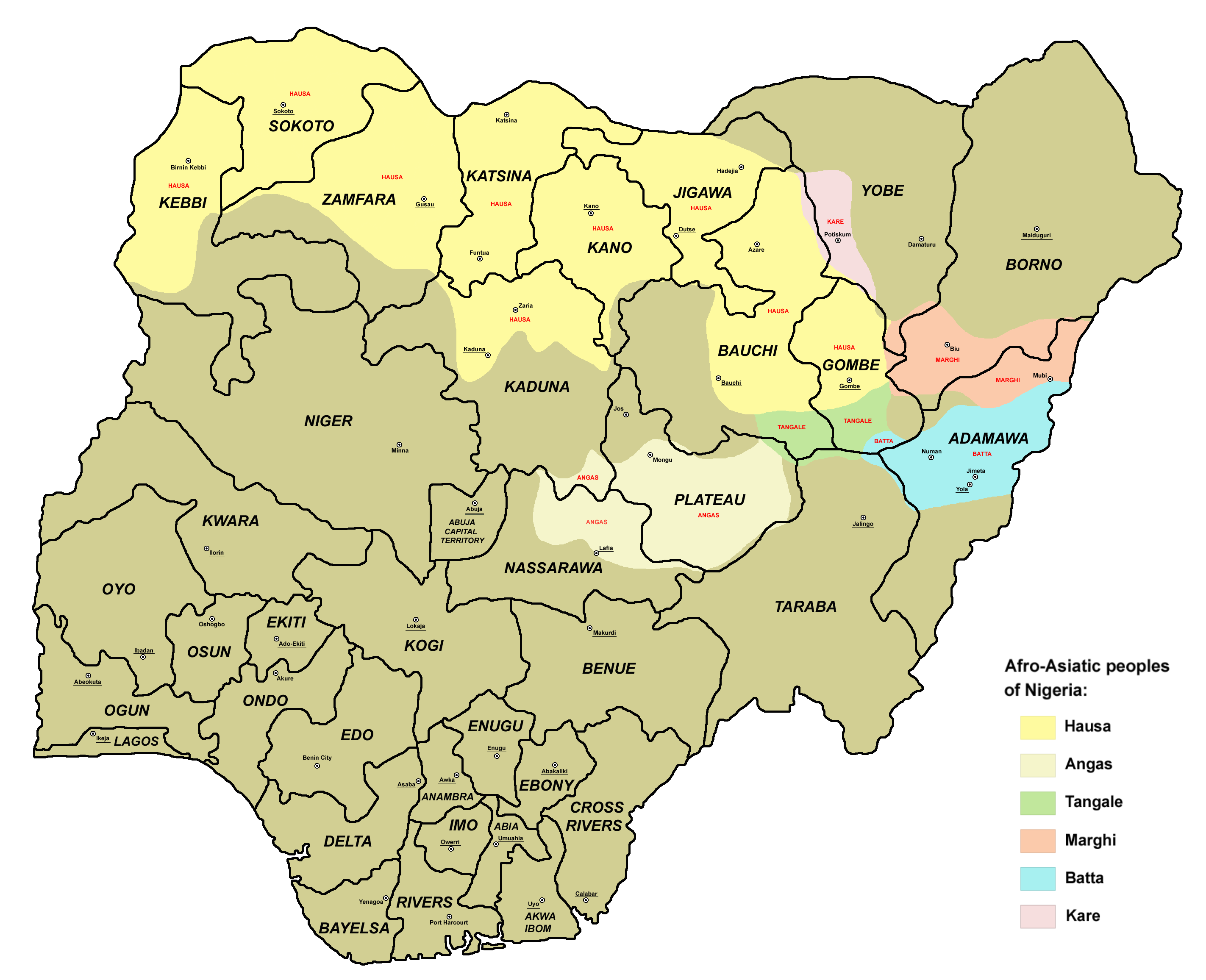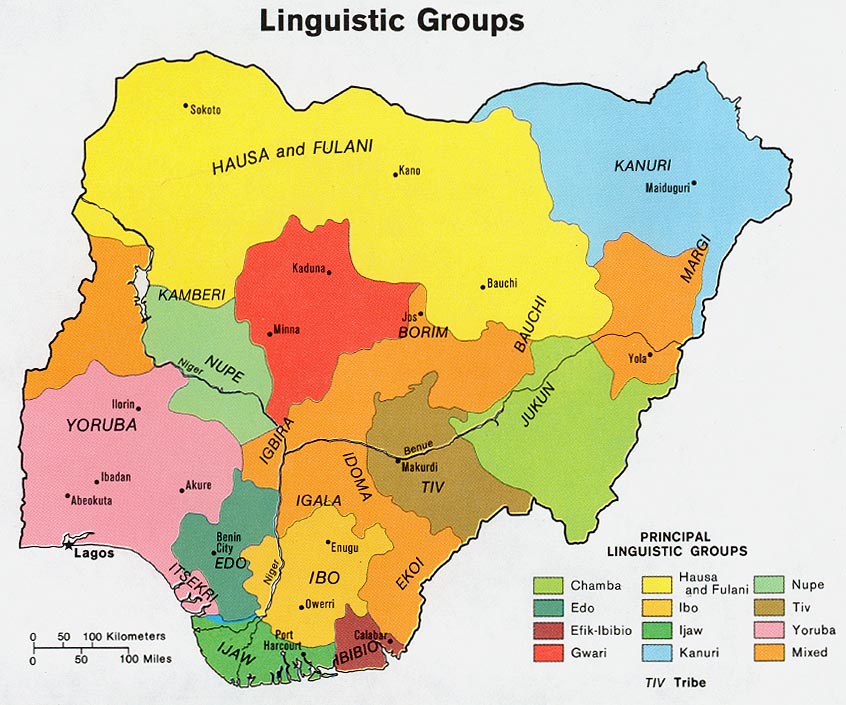|
Jara Language
Jara, also known as Jera, is a Nigerian language reported to be spoken by 46,000 people in 2000. It is spoken in Borno and Gombe States, in the Biu, Kwaya-Kusar, Akko, and Yamaltu-Deba LGAs. It is an Afro-Asiatic language, in the Biu–Mandara branch of Chadic family. Use of Jara is declining; it is being displaced by Fulfulde and Hausa Hausa may refer to: * Hausa people, an ethnic group of West Africa * Hausa language, spoken in West Africa * Hausa Kingdoms, a historical collection of Hausa city-states * Hausa (horse) or Dongola horse, an African breed of riding horse See also .... References Languages of Nigeria Biu-Mandara languages {{BiuMandara-lang-stub ... [...More Info...] [...Related Items...] OR: [Wikipedia] [Google] [Baidu] |
Chadic Languages
The Chadic languages form a branch of the Afroasiatic language family. They are spoken in parts of the Sahel. They include 150 languages spoken across northern Nigeria, southern Niger, southern Chad, the Central African Republic, and northern Cameroon. The most widely spoken Chadic language is Hausa, a ''lingua franca'' of much of inland Eastern West Africa. Composition Paul Newman (1977) classified the languages into the four groups which have been accepted in all subsequent literature. Further subbranching, however, has not been as robust; Roger Blench(2006), for example, only accepts the A/B bifurcation of East Chadic. Kujargé has been added from Blench (2008), who suggests Kujargé may have split off before the breakup of Proto-Chadic and then subsequently became influenced by East Chadic. Subsequent work by Joseph Lovestrand argues strongly that Kujarge is a valid member of East Chadic. The placing of Luri as a primary split of West Chadic is erroneous. Bernard Caron (200 ... [...More Info...] [...Related Items...] OR: [Wikipedia] [Google] [Baidu] |
Biu–Mandara Languages
The Biu–Mandara or Central Chadic languages of the Afro-Asiatic family are spoken in Nigeria, Chad and Cameroon. A reconstruction of Proto-Central Chadic has been proposed by Gravina (2014). Languages Gravina (2014) Gravina (2014) classifies Central Chadic as follows, as part of a reconstruction of the proto-language. Letters and numbers in parentheses correspond to branches in previous classifications. The greatest changes are breaking up and reassigning the languages of the old Mafa branch (A.5) and Mandage (Kotoko) branch (B.1). *South **South ***Bata (A.8) ****Bata Proper: Bacama, Bata, Fali, Gude, Gudu, Holma (†), Jimi, Ngwaba (from A.1 Tera), Nzanyi, Sharwa ****Tsuvan: Tsuvan, Zizilivakan ***Daba (A.7) ****Daba Proper: Daba, Mazagway Hidi ****Mina: Mina, Mbudum ****Buwal: Buwal, Gavar ***Mafa (= South A.5 Mafa (d)): Mafa, Mefele, Cuvok ***Tera (A.1): ****East Tera: Boga, Ga'anda, Hwana ****(West Tera): Jara, Tera *** Sukur (A.6) *Hurza **Hurza (fr ... [...More Info...] [...Related Items...] OR: [Wikipedia] [Google] [Baidu] |
Tera Languages
TERA is a shielded twisted pair connector for use with Category 7 twisted-pair data cables, developed by The Siemon Company and standardised in 2003 by the International Electrotechnical Commission (IEC) with the reference IEC 61076-3-104. The 2006 revision of the standard extended the characterised performance up to 1000 MHz. The connector has a different footprint from the more common 8P8C connector. TERA is also a useful interface for broadcast communications technology (BCT). This connector allows for cable sharing, permitting users to integrate video, voice and data services over a single cabling link. See also * GG45 GG45 (GigaGate 45) and ARJ45 (Augmented RJ45) are two related connectors for Category 7, Category 7A, and Category 8 telecommunication cabling. The GG45 interface and related implementations are developed and sold by Nexans S.A., while the ... or ARJ45, a connector for high-speed Category 7 cable References External links * Networking ... [...More Info...] [...Related Items...] OR: [Wikipedia] [Google] [Baidu] |
Borno State
Borno State is a state in the North-East geopolitical zone of Nigeria, bordered by Yobe to the west, Gombe to the southwest, and Adamawa to the south while its eastern border forms part of the national border with Cameroon, its northern border forms part of the national border with Niger, and its northeastern border forms all of the national border with Chad, being the only Nigerian state to border three foreign countries. It takes its name from the historic emirate of Borno, with the emirate's old capital of Maiduguri serving as the capital city of Borno State. The state was formed in 1976 when the former North-Eastern State was broken up. It originally included the area that is now Yobe State, which became a distinct state in 1991. Borno is the second largest in area of the 36 states, only behind Niger State. Despite its size, the state is the eleventh most populous with an estimated population of about 5.86 million as of 2016. Geographically, the state is divided betw ... [...More Info...] [...Related Items...] OR: [Wikipedia] [Google] [Baidu] |
Gombe State
Gombe State ( ff, Leyddi Gommbe 𞤤𞤫𞤴𞤣𞤭 𞤺𞤮𞤥𞥆𞤦𞤫) is a state in northeastern Nigeria, bordered to the north and northeast by the state of Borno and Yobe, to the south by Taraba State, to the southeast by Adamawa State, and to the west by Bauchi State. Named for the city of Gombe—the state's capital and largest city—Gombe State was formed from a part of Bauchi State on 1 October 1996.The state is among the multi lingual states in Nigeria. Of the 36 states of Nigeria, Gombe is the 21st largest in area and 32nd most populous with an estimated population of about 3.25 million as of 2016. Geographically, the State is within the tropical West Sudanian savanna ecoregion. Important geographic features include Gongola River, which flows through Gombe's north and east into Lake Dadin Kowa, and part of the Muri Mountains, a small range in the state's far south. Among the state's nature are a number of snake species including carpet viper, puff adder, and ... [...More Info...] [...Related Items...] OR: [Wikipedia] [Google] [Baidu] |
Afro-Asiatic Language
The Afroasiatic languages (or Afro-Asiatic), also known as Hamito-Semitic, or Semito-Hamitic, and sometimes also as Afrasian, Erythraean or Lisramic, are a language family of about 300 languages that are spoken predominantly in the geographic subregions of Western Asia, North Africa, the Horn of Africa, and parts of the Sahara/ Sahel. With the exception of its Semitic branch, all branches of the Afroasiatic family are exclusively native to the African continent. Afroasiatic languages have over 500 million native speakers, which is the fourth-largest number of native speakers of any language family (after Indo-European, Sino-Tibetan, and Niger–Congo). The phylum has six branches: Berber, Chadic, Cushitic, Egyptian, Semitic, and Omotic. The most widely spoken modern Afroasiatic language or dialect continuum by far is Arabic, a ''de facto'' group of distinct language varieties within the Semitic branch. The languages that evolved from Proto-Arabic have around 313 million ... [...More Info...] [...Related Items...] OR: [Wikipedia] [Google] [Baidu] |
Fulfulde
Fula ,Laurie Bauer, 2007, ''The Linguistics Student’s Handbook'', Edinburgh also known as Fulani or Fulah (, , ; Adlam: , , ), is a Senegambian language spoken by around 30 million people as a set of various dialects in a continuum that stretches across some 18 countries in West and Central Africa. Along with other related languages such as Serer and Wolof, it belongs to the Atlantic geographic group within Niger–Congo, and more specifically to the Senegambian branch. Unlike most Niger-Congo languages, Fula does not have tones. It is spoken as a first language by the Fula people ("Fulani", ff, Fulɓe, link=no) from the Senegambia region and Guinea to Cameroon, Nigeria, and Sudan and by related groups such as the Toucouleur people in the Senegal River Valley. It is also spoken as a second language by various peoples in the region, such as the Kirdi of northern Cameroon and northeastern Nigeria. Nomenclature Several names are applied to the language, just as to the Fu ... [...More Info...] [...Related Items...] OR: [Wikipedia] [Google] [Baidu] |
Hausa Language
Hausa (; /; Ajami: ) is a Chadic language spoken by the Hausa people in the northern half of Nigeria, Ghana, Cameroon, Benin and Togo, and the southern half of Niger, Chad and Sudan, with significant minorities in Ivory Coast. Hausa is a member of the Afroasiatic languages, Afroasiatic language family and is the most widely spoken language within the Chadic languages, Chadic branch of that family. Ethnologue estimated that it was spoken as a first language by some 47 million people and as a second language by another 25 million, bringing the total number of Hausa speakers to an estimated 72 million. In Nigeria, the Hausa-speaking film industry is known as Hausa-language cinema, Kannywood. Classification Hausa belongs to the West Chadic languages subgroup of the Chadic languages group, which in turn is part of the Afroasiatic languages, Afroasiatic language family. Geographic distribution Native speakers of Hausa, the Hausa people, are mostly found in southern ... [...More Info...] [...Related Items...] OR: [Wikipedia] [Google] [Baidu] |
Languages Of Nigeria
There are over 525 native languages spoken in Nigeria. The Nigerian official language is English, the language of former colonial British Nigeria. As reported in 2003, Nigerian Pidgin was spoken as a second language by 60 million people in Nigeria. The major native languages, in terms of population, are Hausa (over 80 million when including second-language, or L2, speakers), Yoruba (over 50 million including L2 speakers), Igbo (over 30 million, including L2 speakers), Efik-Ibibio cluster (over 15 million), Fulfulde (13 million), Kanuri (8 million), Tiv (5 million), Nupe (3 million) and approx. 2 to 3 million each of Karai-Karai Kupa, Kakanda, Edo, Igala, Idoma and Izon. Nigeria's linguistic diversity is a microcosm of much of Africa as a whole, and the country contains languages from the three major African language families: Afroasiatic, Nilo-Saharan and Niger–Congo. Nigeria also has several as-yet unclassified languages, such as Centúúm, which may represent a r ... [...More Info...] [...Related Items...] OR: [Wikipedia] [Google] [Baidu] |






